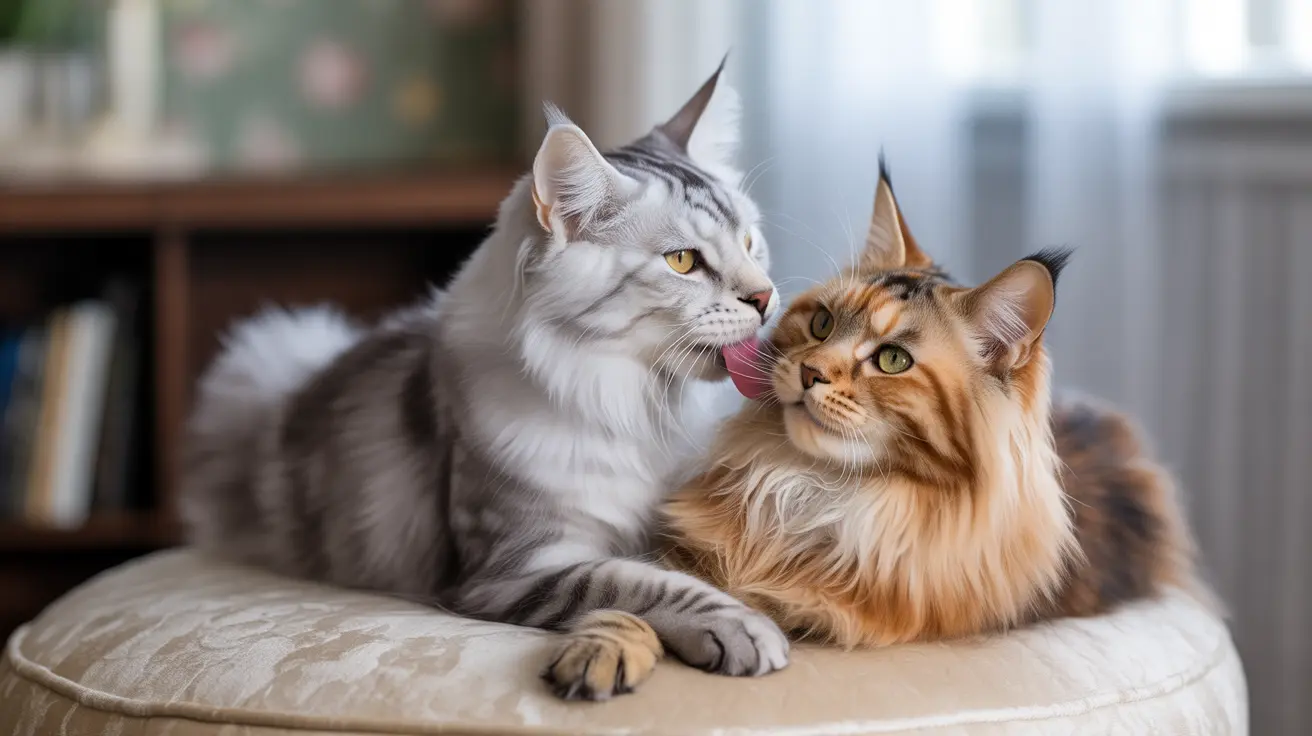When it comes to fascinating feline behaviors, allogrooming stands out as one of the most interesting social interactions among cats. This intimate act of one cat grooming another serves multiple purposes, from strengthening social bonds to maintaining physical health within feline communities.
In this comprehensive guide, we'll explore the science behind allogrooming, its significance in cat social structures, and why your feline friend might extend this behavior to you as their human companion.
What Is Allogrooming and Why Do Cats Do It?
Allogrooming is the practice of social grooming between cats, typically focusing on hard-to-reach areas like the head and neck. This behavior goes far beyond simple hygiene maintenance, serving as a complex social tool that helps establish and maintain relationships within feline groups.
Cats engage in this behavior through a specific process, often beginning with friendly signals such as tail-up greetings or gentle head bumps before the actual grooming begins. The grooming cat will use their rough tongue to methodically clean their companion, while the recipient usually remains still and may purr contentedly.
The Social Significance of Feline Grooming
In the cat world, allogrooming represents much more than just keeping clean. It serves as a powerful social currency, indicating trust, affection, and acceptance within a group. Research shows that cats are more likely to groom preferred companions and family members rather than strangers.
Dominant cats often initiate grooming sessions, using this behavior to reinforce social hierarchies while maintaining group harmony. Studies have found that nearly 80% of grooming interactions are initiated by the more dominant cat in the relationship.
Health Benefits and Biological Importance
Beyond social bonding, allogrooming provides several health benefits for cats. The physical act of grooming helps remove parasites, loose fur, and debris that cats might not be able to reach on their own. This mutual cleaning system has proven so effective that cats prevented from grooming show significantly higher parasite loads.
The behavior also helps distribute natural oils throughout the coat and can help reduce stress levels in both the grooming and receiving cats. This explains why you might often see cats grooming each other during potentially stressful situations.
When Cats Groom Their Humans
If your cat occasionally grooms you by licking your hand or face, they're extending a significant social gesture. This behavior indicates that they view you as part of their social group and trust you enough to engage in this intimate interaction.
Human-directed grooming might also serve as a way for cats to mark you with their scent, effectively claiming you as part of their family group. Some cats may also groom their humans to seek attention or simply because they enjoy the salty taste of human skin.
Managing Multiple Cat Households
Understanding allogrooming can help cat owners better manage multi-cat households. Observing grooming patterns between cats can provide valuable insights into their social relationships and overall well-being. Positive grooming interactions often indicate successful social integration and harmonious relationships.
However, it's important to monitor these interactions, as excessive grooming or grooming followed by aggressive behavior might signal underlying social tension or health issues that need addressing.
Frequently Asked Questions
What is allogrooming in cats and why do they groom each other?
Allogrooming is social grooming between cats that serves multiple purposes: strengthening social bonds, maintaining hygiene, and establishing group hierarchies. Cats groom each other to show affection, reduce tension, and help clean hard-to-reach areas.
How does allogrooming help cats bond and communicate within a group?
Allogrooming facilitates bonding by creating positive associations between cats, spreading group scents, and reinforcing social relationships. It's a form of non-verbal communication that expresses trust and acceptance within the group.
Can allogrooming between cats prevent fights and reduce aggression?
Yes, allogrooming often serves as a tension-diffusing mechanism, helping cats avoid physical confrontations. It's a peaceful way to maintain social order and prevent aggressive encounters.
What are the health benefits and risks of allogrooming in cats?
Benefits include parasite removal, coat maintenance, and stress reduction. Risks include potential disease transmission between cats and occasional aggressive behavior following grooming sessions.
Why do some cats groom their human owners and what does it mean?
Cats groom their humans as a sign of affection and acceptance into their social group. This behavior indicates trust and is similar to how they treat preferred feline companions.
Conclusion
Allogrooming represents a fascinating aspect of feline behavior that combines practical grooming benefits with complex social communication. Understanding this behavior can help cat owners better appreciate their pets' social needs and relationships, whether with other cats or their human family members.






